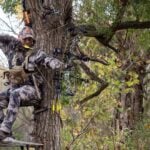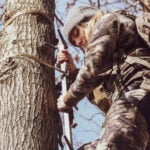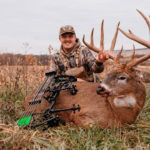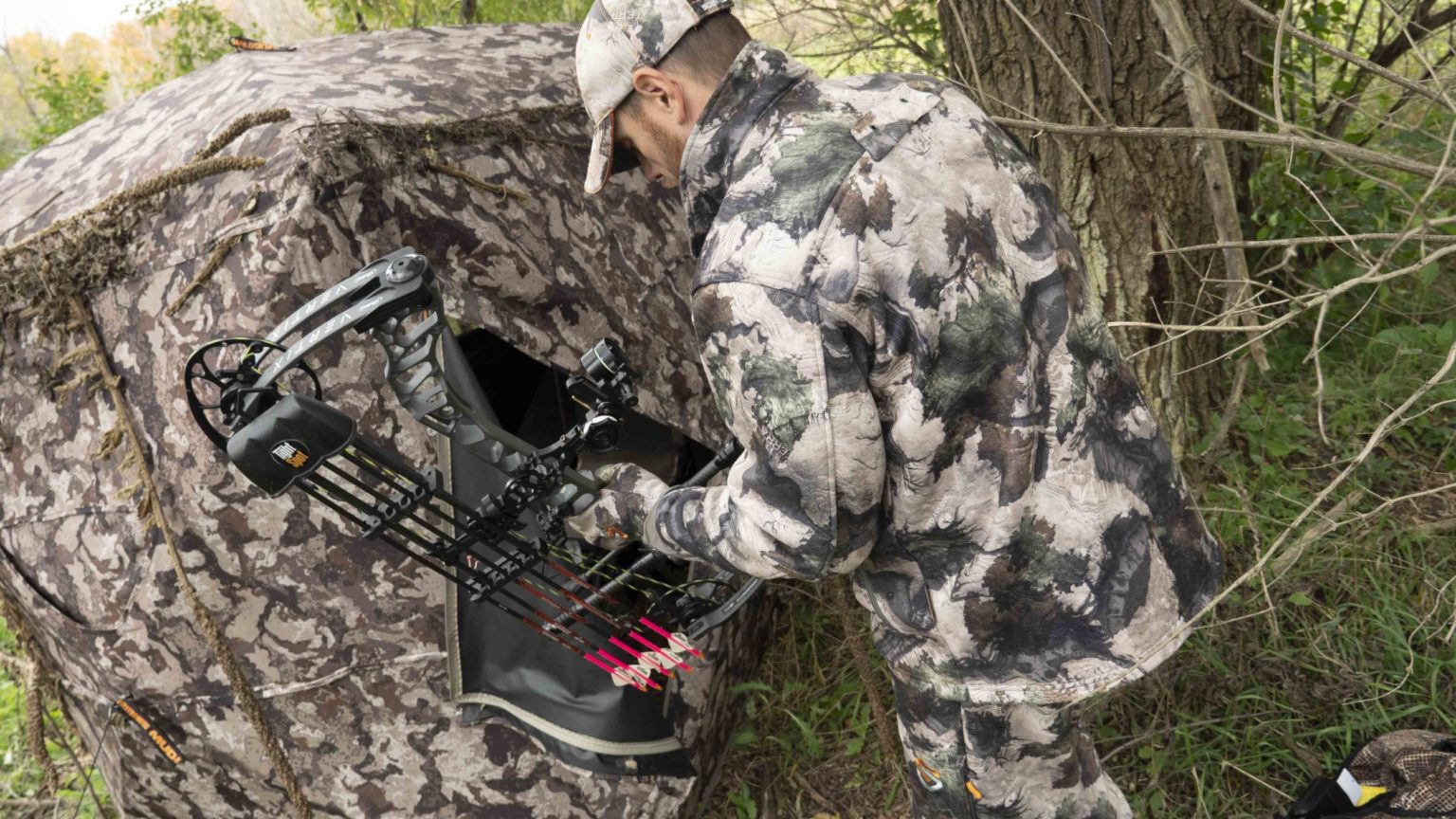
There are two separate situations where ground blinds can be very productive even when trees are available. The first occurs when a buck is approaching a specific part of a feeding area regularly but using a variety of trails.
The second opportunity occurs when hunting in locations that are protected from the wind. Typically, these areas have great sign – ditch and creek crossings and other narrow funnels used heavily by traveling deer – but they are nearly impossible to hunt from a tree stand because of swirling winds.
Food Sources
Hunting where deer feed has always presented a difficult challenge: keeping deer on other trails from smelling you. For this reason, it is tough to lay the perfect ambush. It seems there is always some chance of being picked off.
For example, suppose you’ve been watching an alfalfa field on and off for most of the month of September. There is one particularly nice buck coming out that you would love to see on the other side of your 20-yard pin when the season opens, but he uses two or three different trails.
You take your chances and put your stand up where it covers the one he uses most often. But, your dream goes up in a puff of smoke when a group of does and fawns using a trail downwind of your stand catch your scent and stomp and snort for ten minutes.
In most feeding areas there is no setup in which the wind and the game cooperate 100%. If you hunt a stand when the wind is blowing into the timber, every deer will smell you long before they would otherwise come out.
If you hunt with the wind blowing parallel to the edge of the woods, you will generally have at least one trail downwind. Again, the odds favor getting busted.
And, if you hunt with the wind blowing out into the field, any deer that get past you and into the field before the buck (the biggest bucks usually come out last) will scent you and spook.
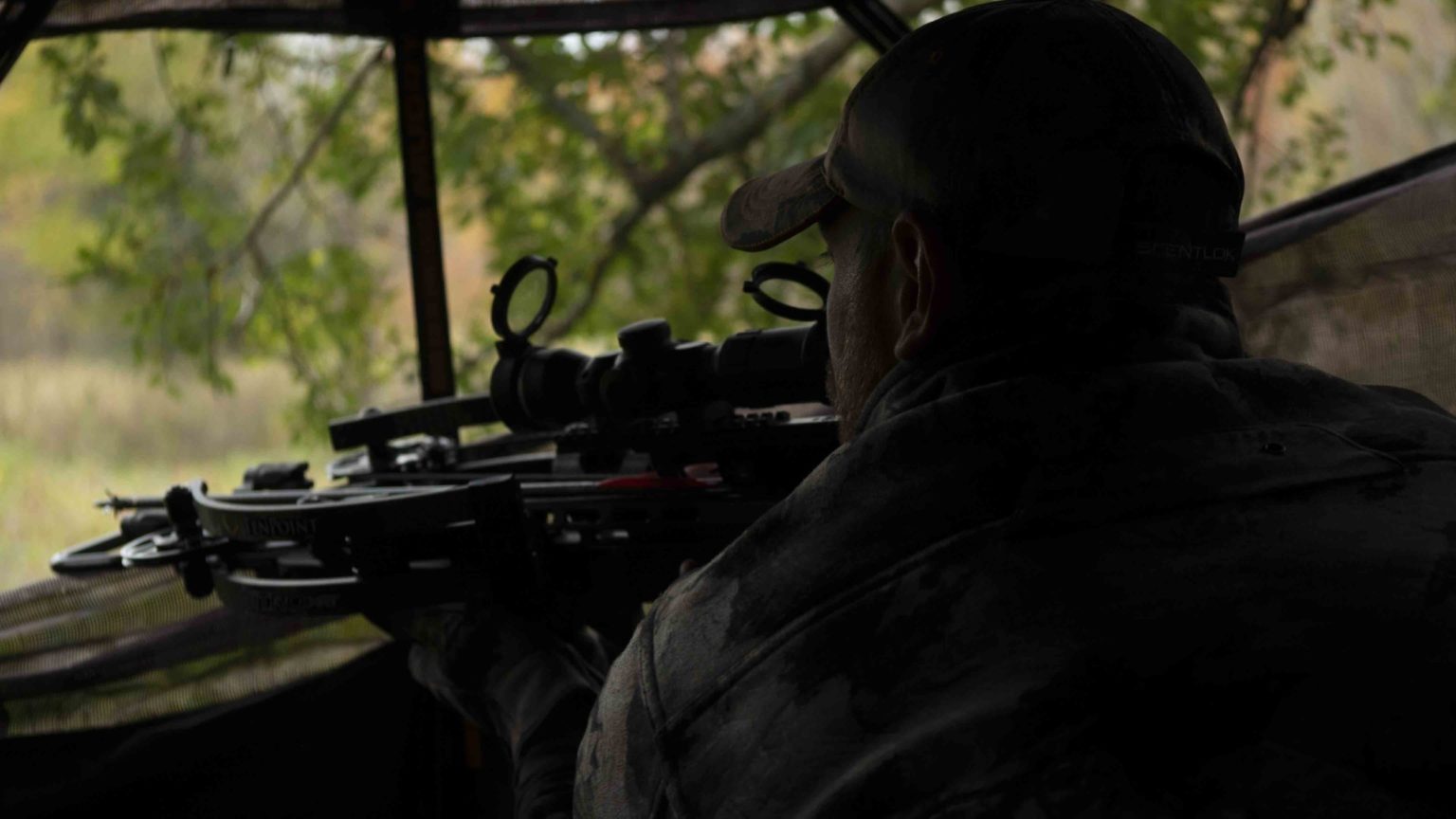
Ground blinds offer a definite advantage in this situation. You can cut off the angles by hunting right in the middle of the food source.
You don’t need to guess which trail the buck will use; you only need to know where he likes to feed. This greatly simplifies hunting strategies especially in and around small to medium-sized food plots. You don’t have to study the area for days on end trying to come up with an intricate plan that keeps non-target deer from smelling you.
Granted, eliminating the decision of which trail to hunt is only half the game. A hunter still has to consider scent. With the blind right in the middle of the food source, deer are likely to be feeding on all sides – upwind and down – by nightfall.
That would definitely be bad if they smelled you, but today’s well constructed ground blinds actually solve this problem by containing your scent.
For background, let me tell the stories of the three bucks my friends shot a few seasons back. Larry Zach shot his buck first from a blind that he made himself by completely encasing a wire mesh frame with plastic sheeting.
The plastic served to hold Larry’s scent in the blind. He used cellophane-covered shooting windows to permit adequate visibility while effectively containing his scent.
Larry said that he tried to sit in the blind during observation trips in the summer but found that he nearly suffocated from the heat and lack of fresh air. Now that’s what I call hard-core scent control measures.
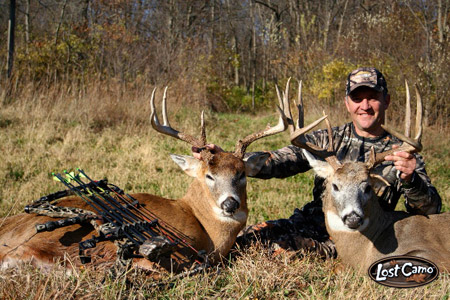
A few test shots showed that Larry was able to shoot through the cellophane windows without affecting arrow flight. The buck he arrowed had a gross-score in the mid-160’s and fell in early October after a week of hunting.
Larry had dozens of deer downwind of his blind during that time and they never picked up his scent. In fact, Larry found that he was able to open the downwind windows of the blind to keep from suffocating without any adverse scent affect.
Dan Knasel shot a dandy 10-pointer about a month later. That buck grossed 152 inches and was chasing a doe around the field on the day he met Mr. Thunderhead. When he paused at 25 yards and offered a good broadside shot, Dan made a perfect double-lung hit and the buck fell 40 yards away.
Dan’s blind of choice was manufactured by Game Tracker. He controlled his scent by keeping all the windows closed except those that were absolutely required to make the shot.
Dan hunted the blind seven evenings over a two-week period before taking the buck and often had other deer downwind of the blind without showing any sign of smelling him.
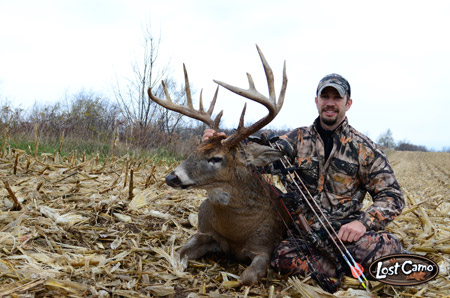
Jim Hill was next. He hunted an alfalfa field on and off for the better part of two months, but it wasn’t until after the peak of the rut – during the last few days of November – that he decided he’d passed up enough bucks.
When a 145-inch nine-pointer came out to feed and offered a 35-yard broadside shot, Jim made the most of it. Jim was hunting from a Double-Bull T5 Pro Staff blind that featured a weatherproof, windproof shell for greater scent containment.
As a further precaution against drafts, Jim used a small folding shovel to dig a trench and bury the skirt of the blind so that scent couldn’t escape out the bottom. Jim also had dozens of deer at close range right downwind of the blind.
All three hunters used activated charcoal clothing to further reduce their scent, but with deer only feet away for long periods at a time, the blind played the deciding role in keeping the hunters from being detected.
I know what you’re thinking, and it is a valid question: how can you hunt repeatedly right in the middle of a feeding area without spooking the deer when you leave? Larry, Dan and Jim used two different approaches depending on the circumstances.
Occasionally, Jim set up his blind on the end of a row of round bales at the field’s edge. When shooting time expired it was easy for him to sneak out using the bales for cover. Most often, however, the blinds were located right in the wide-open. In these instances, arrangements were made for someone else to drive up to the field edge and move the deer off gently using a vehicle.
With this diversion in place, it was easy for the hunter to scramble from the blind and into the truck with little fanfare. There is no question that in time even this method of clearing the field will result in educated deer and fewer sightings, but as long as you don’t hunt the blind every single evening you should be able to keep the area fresh for weeks at a time.
I can think of dozens of situations where this ground blind strategy would have proven extremely valuable to me. For example, I hunted one buck for the better part of two weeks. I almost had him one evening but a couple of does that he was following picked up my scent in the wind and spooked. If I’d been hunting from a blind placed right in the field I believe I would have had that buck easily.
I hunted a field in Montana for a couple of seasons where the bucks came out using a dozen different trails but they always ended up very close to a sparse willow thicket that grew in an irrigation ditch that ran through the middle of the field. I often looked across the field and wished I were sitting in the thicket.
But, my enthusiasm was kept in check by the realization that other deer would surely pick up my scent and movement before the bucks got there. A ground blind would have been deadly in that setting.
Draws and Ravines
Whenever you hunt a stand located in a spot that’s protected from the direct flow of the wind you will have to deal with swirling. I’ve always avoided setting up in such locations because the odds of educating deer are too high.
I’ve had to ignore some awesome looking ditch and creek crossings at the bottoms of ravines simply because I knew I’d eventually be winded by deer in every direction. I’ve also had to forget about stands located overlooking small isolated bottomland food plots simply because I knew any deer entering the plot would eventually smell me.
What I saw last season changed the way I look at tricky wind situations. Because a ground blind serves to contain human scent it permits you to hunt these places. While your visibility and shooting coverage won’t be as good from a ground blind they would be from a tree stand, that is of little consequence if the blind is the only viable option.
Obviously, when hunting in the timber you can use natural cover to help conceal the blind, reducing (or eliminating) the time required for deer to become accustomed to it.
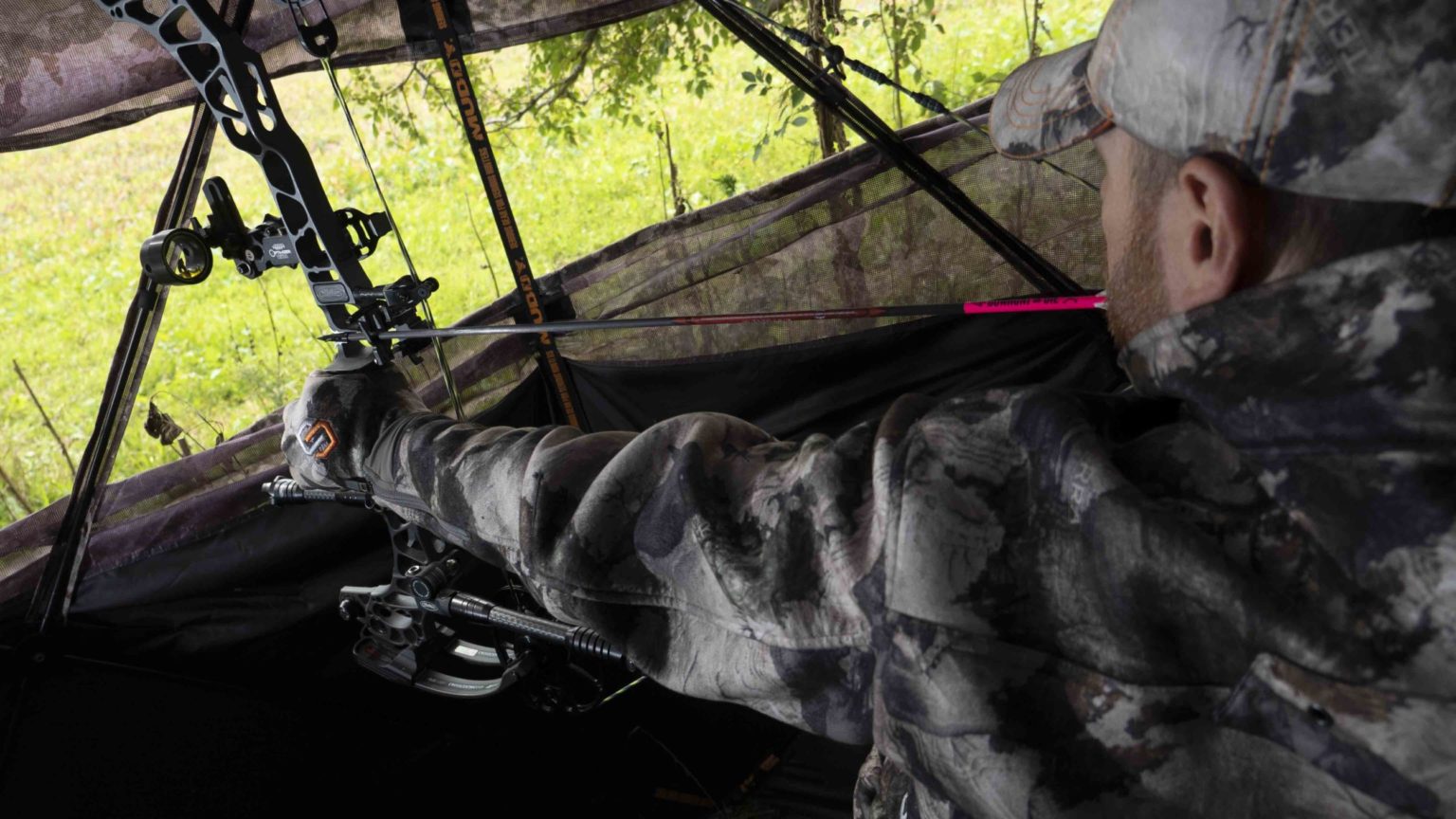
What you Can Get Away With
My friends showed me last season that you don’t have to put the blind up weeks in advance for deer to accept it. I’m sure the reaction of the deer you hunt will be affected by the number of times they’ve experienced hunters in blinds, but the deer Larry, Dan and Jim were hunting had very little prior experience with blinds and were not afraid of them.
On more than one occasion, 3 ½ year old bucks were seen within bow range of the blind the very first evening it was put out. Deer typically exhibited some caution around the blind at first, but once the first one checked it out and gave the OK the rest of the herd seemed to completely forget about the blind.
In other words, as long as the does are feeding contentedly in the field, the bucks that come out after them seem to pay the blind little attention. Of course, to be on the safe side it would be an advantage to have the blind up several days before you actually plan to start using it just so there is no risk of wasting a precious evening of hunting.
Larry and Jim went to considerable trouble to add brush to their blinds with limbs cut from trees along the edge of the field, but Dan just set it up and started hunting. He added no brush to the blind whatsoever.
Again, it is dangerous to draw too much inference from limited anecdotal experiences, so you would be wise to err on the side of safety and make every effort to break up the sharp outline of the blind. If you are hunting an alfalfa field make your blind look as much like a round bale as possible (assuming they are typical farming practice where you hunt).
You might even offer to pay the farmer to leave one bale in the field in a location where you expect deer to feed and then place your blind next to that. It is unlikely that deer will notice the blind under that condition especially if you cover it with a bit of netting woven with hay.
Fine Points to Consider
Hunting from a blind is not the same experience as hunting from a tree stand. I hunted turkeys from ground blinds for a couple of years with a bow and found the experience to be less enjoyable than being out the open air with the wind in my face.
The same can be said of ground blinds used for deer hunting. However, under the right conditions, enduring the “closet” affect seems a reasonable tradeoff for shooting a big deer.
Also, blinds need to be kept very clean or you will introduce foreign odors. Always make sure when putting away your blind that it is completely dry so it won’t mildew in storage. Keep it in a place that is free of offensive odors. In other words, the garage is a poor choice.
Finally, choose a blind that has a darkened interior so deer can’t see into the blind. By the same token, open as few windows as absolutely necessary so that you introduce no extra light or create a “see-through” situation where a deer could spot your outline moving between two open windows.
A dedicated hunter I know feels that you must wear a carbon suit for the blind to do the best job of controlling your scent. Dennis also believes that you should vent the blind from time-to-time by opening an upwind and downwind window so that your bottled scent has a chance to escape at a time when there are no deer downwind. This keeps the blind from “leaking” concentrated scent at an inopportune time.
If you have never taken ground blinds seriously you are missing out on a tool that can improve your odds for success when hunting food sources and locations where the wind is fickle. Good manufactured models aren’t cheap, but they do represent an investment that will make you a more versatile and effective bowhunter.

